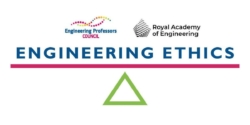 Authors: Dr Sarah Junaid (Aston University); Emma Crichton (Engineers Without Borders UK); Professor Dawn Bonfield MBE (Aston University); Professor Chike Oduoza (University of Wolverhampton); Johnny Rich (Engineering Professors’ Council); Steven Kerry (Rolls-Royce); Isobel Grimley (Engineering Professors’ Council).
Authors: Dr Sarah Junaid (Aston University); Emma Crichton (Engineers Without Borders UK); Professor Dawn Bonfield MBE (Aston University); Professor Chike Oduoza (University of Wolverhampton); Johnny Rich (Engineering Professors’ Council); Steven Kerry (Rolls-Royce); Isobel Grimley (Engineering Professors’ Council).
Topic: Ethical entrepreneurship in engineering industries.
Engineering disciplines: Mechanical engineering, Electrical and electronic engineering, Chemical engineering.
Ethical issues: Justice, Corporate social responsibility, Accountability.
Professional situations: Company growth, Communication, Public health and safety.
Educational level: Beginner to advanced.
Educational aim: To encourage ethical motivation. Ethical motivation occurs when a person is moved by a moral judgement, or when a moral judgement is a spur to a course of action.
Learning and teaching notes:
This case involves the CEO of Hydrospector, a newly formed company that makes devices detecting water leaks. The CEO has been working hard to secure contracts for her new business and has a personal dilemma in structuring her business model. She must balance the need to accelerate growth by working with high revenue global corporations, with her desire to bring a positive impact to the communities with greatest need. By working with less wealthy local authorities, the company risks slower business growth.
This dilemma can be addressed from a micro-ethics point of view by analysing personal ethics, intrinsic motivations and moral values. It can also be analysed from a macro-ethics point of view, by considering: corporate responsibility in perpetuating inequity versus closing the inequality gap; and sustainability in terms of the local socioeconomic system.
There is also a clear cultural context in this case study that provides an opportunity to develop cultural awareness when addressing engineering problems. Through this lens, this case can be structured to emphasise the need to engage with local communities and stakeholders – such as a UK company choosing to engage with its local community first. Or it can be framed to emphasise global responsibility whereby the CEO of a UK company chooses to address water shortages in South Africa.
This case study addresses two of AHEP 4’s themes: The Engineer and Society (acknowledging that engineering activity can have a significant societal impact) and Engineering Practice (the practical application of engineering concepts, tools and professional skills). To map this case study to AHEP outcomes specific to a programme under these themes, access AHEP 4 here and navigate to pages 30-31 and 35-37.
The case study is presented in three parts. Part one introduces the case and discusses personal and corporate ethical dilemmas, with an emphasis on ethical awareness. Pre-reading may be needed on the environmental, social, and governance (ESG) mandate and / or corporate social responsibility (CSR). Part two expands on Part one to bring in the socio-political elements of corporate responsibility. For Part three, instructors or programme directors could incorporate this exercise in projects that involve product development, with students working through Part one and two as examples. This part aims to encourage ethical action on the part of students who are developing their own products, so that they can consider aspects of justice, responsibility, and sustainability in their engineering solutions. This case also allows teachers the option to stop at multiple points for questions and / or activities as desired.
Learners have the opportunity to:
- determine if an engineering situation has ethical dimensions and identify what these are;
- identify where tensions might arise as an engineer versus a business owner;
- explore how a business model operates with its potential impact on society and the local / global economy;
- practise stakeholder mapping;
- debate possible solutions to an ethical dilemma.
Teachers have the opportunity to:
- highlight professional codes of ethics and their relevance to engineering situations;
- address approaches that resolve interpersonal and / or professional conflict;
- integrate technical content on fluid mechanics (such as conservation of mass, systems engineering] or content on electronics [such as developing a sensor for water flow detection);
- integrate engineering content with business and entrepreneurial leadership;
- informally evaluate students’ critical thinking and communication skills.
Learning and teaching resources:
- RAEng/Engineering Council Statement of Ethical Principles
- IMechE Code of Conduct Explained
- Environmental, social, and governance (ESG) mandate
- Indian law requires companies to give 2% of profits to charity. Is it working?
- A Moment for Change?
- Sustainability & CSR – Ethics Unwrapped
- Strength, Weakness, Opportunity, and Threat (SWOT) Analysis
Foreword and suggested pre-reading for Part one:
In the last few years, there have been calls for more corporate responsibility in environmental and socioeconomic ecosystems globally. For example:
- In 2006, the ESG mandate was set up by a group of investors to create a more sustainable financial system for companies to operate in, and to use as part of their annual reporting of performance indicators.
- In 2014, India was the first country in the world to make it mandatory for companies that meet a certain profit threshold to give 2% to charitable causes. See the following article: Indian law requires companies to give 2% of profits to charity. Is it working?
- In 2017, the economist Kate Raworth set out to reframe GDP growth to a different indicator system that reflects on social and environmental impact. See the article: A Moment for Change?
Part one:
Maria is a young co-founder and technical lead (CTO) living in the UK looking at the business development of her newly-formed transnational company, Hydrospector, based in Johannesburg (Joburg), South Africa, where her co-founder/CEO is located. The company makes devices that detect water leaks and the small team has been working hard to secure contracts for their new business. Maria is an electrical and electronics engineer by training and was the lead inventor for this technology. She has proven her technology works in detecting leaks early and at low levels, lowering the risk of damage to infrastructure that impacts local communities. The technology will also save companies millions each year by detecting low-level water loss that currently remains undetected. Her company is now in a position where they need to find customers.
Targeting big corporations will mean her technology will get out much more quickly and be a huge economic benefit to surrounding industries and society. Maria comes from a lower socioeconomic background in Lancashire (UK) and her personal experience of the economic disparity between the different areas she has lived in, means she feels strongly about not wanting to perpetuate this norm. She feels that Hydrospector’s business growth model needs to have a more active approach in preventing the widening of the socioeconomic gap. In Joburg, where the company is based, there are stark differences in the affluence of neighbouring communities. Should she focus on working with poorly-funded local authorities to help ensure their product gets to the places most in need, rather than prioritise projects that will be more lucrative and accelerate the business more quickly?
Optional STOP for questions and activities:
1. Discussion: Personal values – what personal values are causing the internal conflict for Maria? Does her own background make a difference to the issues at stake? If Maria was from an affluent area / background, how may this have affected her perspective?
2. Discussion: Professional values – what ethical principles and codes of conduct are applicable to this scenario?
3. Discussion: Wider impact – is focusing on profit alone morally inferior to prioritising ESG?
5. Activity: Technical integration – undertake a technical activity in the areas of mechanical, electrical and / or chemical engineering related water flow detection sensors.
Foreword and pre-reading for Part two:
It is useful to learn more about the context (geographical, political, social and cultural) of this case study in order to gain a deeper understanding of the nuances that each scenario brings. The following section outlines the local problems with water supply and misuse in South Africa compared to the UK. The links below are starting points to explore these challenges further and carry out research when working on projects as an engineer. They represent perspectives from news, government, and industry sources.
- In industry communication:
Part two:
The CEO and Operations Manager of Hydrospector is Maria’s friend and co-founder, Lucy, who grew up in Joburg. Like Maria, Lucy grew up experiencing the socioeconomic disparity in her area. Lucy’s passion for bringing benefits to disadvantaged communities makes their collaboration an ideal partnership. The company started trading in South Africa where there is a particular interest from Johannesburg Water, the main local water supply company. Water supply shortages in the region have badly affected the country in recent years. Hydrospector has successfully won a bid with a venture capitalist based in South Africa and has rolled out the sensors in Makers Valley, Joburg, a region that has developed economically in recent years. Soon after, the company also won a contract to install sensors in the Merseyside region of the UK in a trial project co-funded by the local council and United Utilities.
Scenario A – Environmental impact:
Hydrospector’s components are sourced in South Africa with both manufacturing and assembly carried out locally in Joburg. It has taken Lucy and her team a year to develop supply and manufacturing operations to run smoothly and economically. To ship to the UK would be a financially better deal for the company than to source and manufacture the product locally in the UK. However, the impact of the carbon footprint would not help their ESG goals. Lucy will have to decide whether to ship the product from South Africa or produce the product locally and therefore set up another operations team in the UK. Setting up in the UK will cost the company more due to component pricing, but would support the local economy. The company could potentially afford to set up UK operations, but this will impact heavily on their financial profit forecast in the first couple of years.
Optional STOP for questions and activities:
1. Discussion: What should Lucy decide? What considerations does she need to make for supply chain management, when considering local customers compared to global ones?
2. Discussion: What could be the unintended consequences of her decision? Consider this question from the following points of view: environmental, economic and social – the public view.
Scenario B – Unintended outcomes:
After six months’ post-installation work in inner-city Bertrams, Makers Valley, Johannesburg Water has contacted Hydrospector about the illegal tapping of its pipes. They suspect water is being stolen from these settlements according to data from the installed sensors. Furthermore, engineers from Johannesburg Water carrying out maintenance work have found some of the sensors have been deliberately damaged, which they suspect has been done so that illegal tapping goes undetected. Johannesburg Water wants to prosecute those responsible and has contacted Lucy to provide all the data logged from the sensors and the time/date stamps to identify specific details about damage. Lucy, however, is aware of cases where funds intended to be used to improve infrastructure for low-income households such as electricity, water supply and sanitation, have sometimes been poorly managed and at worse embezzled so that the communities are left worse off, with ageing pipes and infrastructure. She realises that some illegal tapping may have been done in order to provide for these communities.
Several weeks after this discovery, United Utilities in Merseyside has been in touch about local individuals and companies illegally accessing water from hydrants that are found in street drains for their own usage. These companies have mobile trucks and so have been difficult to find and prosecute. United Utilities would like Hydrospector’s full co-operation in providing the logging data needed, as well as installing sensors at targeted locations where they suspect misuse is happening. Lucy’s research has found that 99% of leakages in the UK are not illegally sourced but rather are due to poor pipe networks. In fact, 20% of water supply loss in the UK is due to leaks and paid for by the customer (domestic users).
Optional STOP for questions and activities:
1. Discussion: How should Hydrospector respond to the two requests? Should the response be the same or different? If the same, why? If different, what makes the two cases different?
2. Discussion: Should water supply companies ultimately be responsible for water leakages? If so, why are they charging domestic users for the 20% water loss? What are the environmental implications of this business decision?
3. Discussion: Maria and Lucy are also concerned that, if these cases were to be picked up by the media, there might be a reputational risk for the company and their ability to achieve their business vision and goals. The co-founders are worried about their product’s unintended consequences., They feel that it could be misused, potentially exacerbate socio-economic inequality further and go against the intended use of the product. Are they right to be concerned? Are they responsible for unintended outcomes?
4. Activity: What role should engineers have in shaping public policy? Often laws and regulations related to policy are dependent on technical knowledge, but some engineers believe it is not their role or responsibility to help shape policy. Debate this issue, or research the relationship between engineering and policy.
Scenario C – Public trust:
Hydrospector has been involved in a project where it surveyed and identified significant leakages and damage to the water supply system in one of the communities in Joburg. The company has been asked by the local authorities not to disclose this information to other parties, particularly media outlets, due to the security risks, including potential terrorism. However, this will affect the transparency of the project, which is publicly funded. In addition, reporting these findings could help resolve the problems found, for example, supply and construction companies may be willing to step up to help.
The company suspects that the local authorities are seeking to avoid a public outcry for the sake of impact scores on customer satisfaction. However, without public knowledge, change to improve the situation is likely to be slow.
Optional STOP for questions and activities:
1. Discussion: Should the company keep the data unpublished or report the data? What ethical reasons can you identify for either choice?
2. Discussion: Should transparency be prioritised over public trust every time? Why or why not?
3. Activity: Debate the above questions by splitting up the students and having each group / individual represent the potential perspectives of United Utilities, Johannesburg Water and Maria / Lucy.
4. Discussion: What guidelines should companies be given for releasing publicly funded data and data misuse?
Foreword and pre-reading for Part three:
This exercise can be supported by technical and non-technical sessions such as business models, SWOT analysis, project management and risk.
Part three:
First, introduce Parts one and two of this case study to inform the exercise as part of a student project, such as a final year capstone.
Design a business growth model for an engineered product, identifying the potential socioeconomic impact, providing a viable profitable forecast and a life cycle sustainability assessment. Explore the ESG indicators and Raworth’s Doughnut of social and planetary boundaries as starting points.
Optional STOP for questions and activities:
1. Discussion and activity: Is impact your main priority? What type of impact are you looking to gain for your business? Consider economic, personal, social and environmental impacts – such as research exercise.
2. Discussion: What risks and opportunities can be identified (SWOT) for the different growth models that could be used to achieve the impact you desire?
3. Activity: Create a business growth model and plan based on your critical research.
4. Activity: Draft a CSR plan for this business.
5. Activity: Speak to people in non-engineering fields that can review and help develop your model.
Enhancements:
An enhancement for this case study can be found here.
This work is licensed under a Creative Commons Attribution-ShareAlike 4.0 International License.
Any views, thoughts, and opinions expressed herein are solely that of the author(s) and do not necessarily reflect the views, opinions, policies, or position of the Engineering Professors’ Council or the Toolkit sponsors and supporters.




